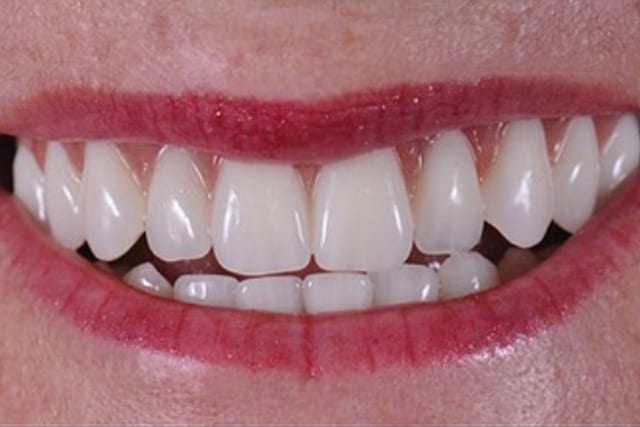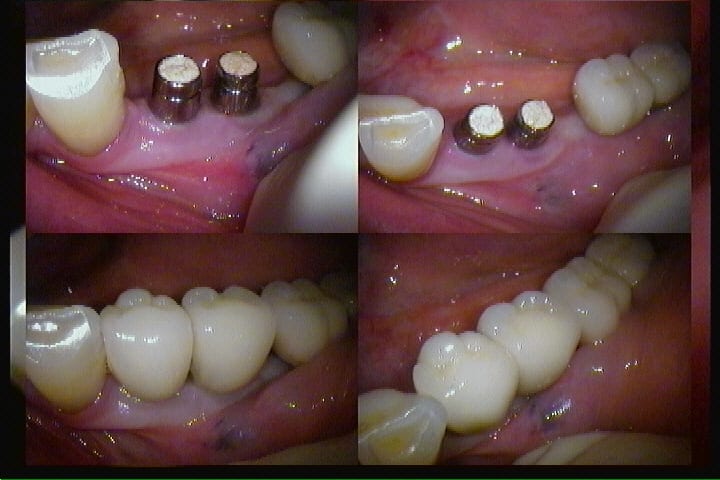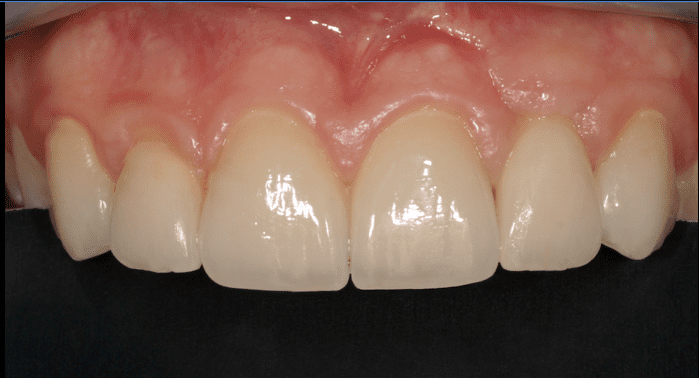Dental Implants in Los Angeles
Dental implants or Tooth Implants are the solution to missing teeth or possibly a tendentious jaw. A Dental Implant is a substitute for the root of a natural tooth, in which the implant will enable restorations including a Dental Implant crown, implant bridge, or implant-supported dentures. The expertise and vision of the dentist are of vital importance.
Not everyone is a candidate for Implant Dentistry, which is why a comprehensive evaluation is critical.
This would include but is not limited to: a thorough examination including past medical conditions; complete dental x-rays; impression of existing teeth; bite analysis; occlusion analysis, wax-up of teeth; CT scan; and surgical stents or templates. A number of patients have come to us with dental implant failures, usually a result of having a less experienced dentist “cut corners”.

Dental Implants Before and After


When It Comes To Dental Implants, This Is No Place To Take Shortcuts
Many Dental Implant failures can be avoided if proper diagnosis is made by gathering the above records as a bare minimum. Sufficient bone mass is required to support the implant; the quality of the bone (porous vs. dense); the dexterity of the dentist; the bite and degree of occlusion; and the overall oral hygiene of the patient.
What is a Dental Implant?
Dental Implants or Tooth Implants are basically screwing or abutments that are surgically placed into the bone. There are various types of implants for dentistry, made by a wide variety of dental companies. Today, most are made of Titanium and are Biocompatible. One of the newer additions is Zirconium Implants which are metal-free, tooth-colored, and very strong. This newer Zirconium Implant has been widely used in Europe and is gaining popularity in the US.

The price can also depend on the experience, knowledge, and reputation of the dental implant dentist performing the treatment. Some All-on-4 or All-on-6 procedures are done using lower-quality implants or with inadequate treatment planning, leading to improper bite alignment, severe halitosis (bad breath), fractures, and other failures. It’s crucial to choose the right dental implant surgeon and dentist to ensure your restoration lasts for many years.
In this case, custom work was included, such as adding pink porcelain to mimic the gums, ensuring the porcelain teeth don’t appear too long.
What Are The Pros and Cons of Dental Implant?
They are not for everyone, and since it is a surgical procedure, everyone should pay close attention to the risks and benefits of the procedure. It is true that the dental implant is the next best thing compared to the natural tooth, but since it is man-made there are pros and cons.
Before and After Front Tooth Implant
Dr. Mobasser is an expert in Implant crowns. In his Los Angeles Implant dental practice, attention is placed to shape, color, and alignment when it comes to front teeth. He works with the restoration of Zirconia Implants which is widely popular in Europe as opposed to Titanium Implants which is mostly used in the USA.
Pros: Implants generally work best in circumstances where one or two teeth are missing, and when the adjacent teeth are virgin (there is no restoration or filling). In such cases, a dental bridge will not be necessary to prepare and cut the adjacent teeth, however if the adjacent teeth have failed or unsatisfactory restoration, then possibly a Bridge can be a good choice for the patient since the adjacent tooth also needs replacement. Other pros include but are not limited to the following: improving the bite and mastication (chewing) functions; cosmetically enhancing the appearance of missing teeth in one’s smile; the possibility of cheek support and/or lip support; the priceless esthetic enhancement of improved self-confidence!
Cons: Those with a compromised medical condition can reject the Implant; it is a 2-stage surgical procedure and can take 3 to 6 months to evaluate whether the Implant has osseointegrated with the bone, and if not, surgical removal is necessary. Therefore, time is an issue. Also, if the bone level is not sufficient, meaning the height and width of the bone is not ideal to receive a tooth implant, then additional surgeries may be required such as a Dental Implant bone graft or for upper back teeth sinus lift procedure, in which additional time and expense are incurred.
What is Bone Graft for a tooth Dental Implant?
Bone Grafting is the procedure in which the surgeon can add additional bone, either artificial, or the individual’s own bone (which is much better), or the surgeon can cause stimulation of bone to encourage regeneration. This bone grafting causes bone regeneration either to the height of the bone or to the width of the bone, so a longer or wider implant be placed in the jawbone for better survival. The longer and the wider the implant inserted in the jawbone, the better survival rate and outcome of the tooth that is placed on the tooth implant, which is acting as the root of a tooth. Also, since the implant is not of the same Biochemistry as our own natural teeth, the implant does not move!
However, our own natural tooth moves due to forces of our bite (very minutely), this scenario can cause food impaction (if placed next to the natural tooth). This is due to the fact that natural teeth can move slightly with the force of the bite or occlusion; however, the implant is enclosed and unable to shift, Dental implant is stable, our own teeth move microscopically, therefore with time, space or food impaction can occur, many patients complain about it.




Dental Implant bridge was used in combination with the single front crown, with pink customized artificial gum, to give the patient his dream smile. The combination of natural front tooth crown with front tooth implants bridge is one of the most challenging dental treatments for any cosmetic dentist, due to different gum heights and different porcelain material needed. He could not be happier!
How long After Dental Implant Can One get the Crown?
The safest time after the initial placement of the surgical implant is at least 3 months. At that time, the surgeon will test if the Implant has taken to (or osseointegrated) with the bone, and there is no mobility. After that, a healing cap will be placed to form the surrounding gum for the placement of the final crown. The Implant dentist will need to determine what kind of Porcelain Crown is the best crown to function and be cosmetically pleasing for the patient’s smile. Usually, there are 2 types of Crowns, each has pros and cons.
Can your gums get infected, after placing Dental Implants?
Your gum can get infected after placing an implant especially when there is an extraction of a tooth that was infected before and the implant dentist extracts and place an immediate implant! There is a 50-50 chance for infection and implant failure, it is best to remove the infected tooth, wait about 3 to 6 months and then place the dental implant.
What are the 2 types of Implant Crowns?
1- Screw on Implant Crown: No cement is used, and the Crown will be seated on the Implant abutment with a screw, this kind of Crown is very safe and kind to the gum and bone structure. The top of the Crown is usually covered with a composite restoration.
2- Cemented Implant Porcelain Crowns: They will be needing a post or an Implant abutment to go on top of the Implant fixture after a crown will be cemented on top of the abutment. These crowns are more aesthetic, however have some cons also. If any excess cement is left, unfortunately, it is documented that the Implant will fail.
What is the Cost of Dental Implants?
The costs depend on so many variables as mentioned above, but generally, there are two components: a surgical portion, and a restorative portion (which can include an implant post), and possibly a Crown. The surgical portion can be anywhere from $1000 to $5000 per tooth depending on the procedure required. The restorative portion, which is after the osseointegration of the implant, can cost from $1500 to $5000 per tooth, depending on the cosmetic needs of the patient, and the dexterity of the dentist.
Nothing is better than your original teeth. However, if you are considering a dental implant, it is best to have a comprehensive evaluation done by an expert dentist, so you would know all options, and can make the most informed decision. Your implants can be done via IV Sedation, aka Twilight Sleep, as your comfort is always Dr. Mobasser’s priority.
Could Dental Implants be placed if there is limited bone structure for denture wearers?
Wearing dentures for a long-time causes bone resorption due to the pressure of dentures exerted on the gums and bones! It is best you see an expert dentist, for a complete evaluation, with a cat scan and MRI, especially the bone level! If the bone level is not sufficient, there are possibilities to add bone so you can get an Implant-supported denture! In which your dentures will not be loose anymore. A minimum of 4 Implants is needed to have Implant-supported dentures.
Removable Dentures, supported by Dental Implants
Loss of teeth can cause older appearance, eating disorders, bite (occlusion) issues, and speaking issues. Removable Dentures are a more affordable way of restoring the teeth, however, they can cause further bone loss due to pressure they exert on the bone ridge, and cause displacement of the denture, making the experience unpleasant. Nowadays with the help of Dental Implants, we can fabricate removable dentures which are supported by Implants!
We can have full dentures fabricated with a minimum of 2 Implants in the lower (Mandibular) jaw, and a minimum of 4 Dental Implants in the upper (Maxillary) jaw to support the dentures, to avoid looseness, and further loss of jaw bone, and confidence. Dr. Mobasser needs to evaluate the existing bone structure, your bite, and your cosmetic needs prior to suggesting if the removable implant-supported dentures may be the right treatment for you.

All-on-6 is preferred over All-on-4 because, if one implant fails, the remaining implants can still support the prosthesis. In contrast, with All-on-4, failure of a single implant can compromise the stability and comfort of the entire restoration. However, factors like bone density and proximity to the sinus in the upper jaw must be carefully evaluated when planning for 4 or 6 implants, and may require bone grafting or additional surgical procedures.
The main considerations with All-on-4 or All-on-6 include the need for excellent oral hygiene to prevent halitosis and an adjustment period for speech. The total cost depends on whether a full zirconia or hybrid prosthesis is used, the number of implants placed, and whether additional bone grafting is necessary based on CT scan evaluation.
Why Implant Crown can get loose?
The major reason for the loose Implant Crown is the screw that joins the abutment to your implant fixture! Implant Crowns can be screw-retained or cemented on top of the implant abutment.
The screw can get loose due to many reasons, but the major reason is due to the heavy load of the bite or occlusion, and if the screw is not an authentic screw and was not tightened to the exact protocol required, the Implant screw can get loose, so the Implant Crown will be loose. Unfortunately, the screw is the major problem and the weakest point in Implant dentistry, and on some occasions, the screw can even break or fracture!
Which one should I choose: Tooth Implant vs Bridge?
If you have a missing tooth due to decay, fracture, bad root canal, you can restore your missing tooth with either Implant or Bridge. Generally, if the adjacent teeth next to missing teeth are virgin, meaning they are healthy and no failing restoration, then the best option is to place a Dental Implant. This way you can floss between your teeth also. If the adjacent teeth are also compromised, then it is best to have a dental bridge, to restore the compromised teeth adjacent and placing the fake tooth supported by those 2 adjacent teeth. Note that when you place a bridge the missing tooth cannot be flossed, since joined, and you will need to use a floss threader. Also note that, the implant is a surgical intervention, will take time vs a bridge which is much faster, and it is not surgical.


Process of Restoring Abutment & Implant Crown
It is possible to have the screw re-tightened again if it is not broken. This is much easier if your Implant Crown is screw-retained, and was not cemented on the abutment (Post) of the Implant fixture (the root). If your crown was cemented then in order to access the screw, the Implant dentist must try to make a hole on the crown to access the screw, or completely cut out the crown and make a new Implant Crown.
Process of Restoring Titanium Abutment Post & Crowns
Dr. Anthony Mobasser aka “Celebrity Dentist”, has performed Cosmetic and Reconstructive Dentistry since 1980, and has utilized Dental implants in many of his full mouth dentistry treatments. He is recognized nationally and internationally, and patients seek his services from all over the world. He is also recognized as America’s Top Dentist.
Tooth Implant in front, in combination with veneers and crowns:

During Dental Implants Procedure


After Dental Implants
Before & After Dental implant 6 in 1 from Dr. Mobasser:


Before and After Dr. Mobasser’s Dental Implants
Can teeth be straightened after Implants?
An implant tooth cannot be straightened, once it is osseointegrated with the bone. That is the whole purpose of the dental implant, so the implant does not move, our natural teeth however move slightly. If for some reason the adjacent teeth are misaligned or they have moved, causing food impaction, the adjacent teeth can be treated with orthodontics, or Invisalign but not the tooth Implant since it is enclosed in the bone.
If the Crown on top of the Implant fixture is misaligned, then a knowledgeable dentist can change the post and the Crown to be aligned with natural teeth. Know that one of the major problems with tooth Implant adjacent to natural teeth is food lodgment and impaction after 5 years or so. This is due to the fact that the Implant fixture does not move, however, our own natural teeth do move, for that reason, the open contact must be restored again to avoid periodontal problems!